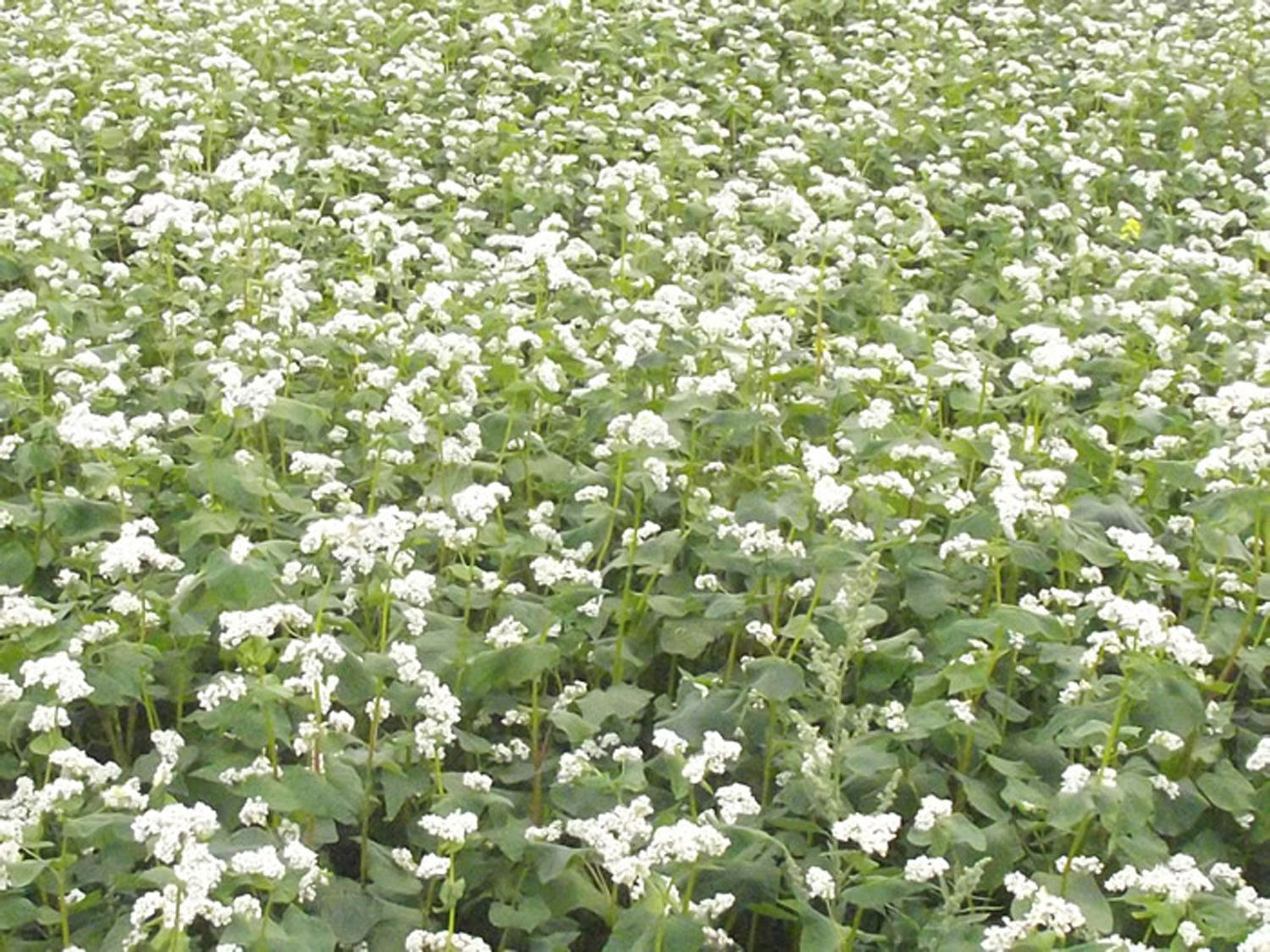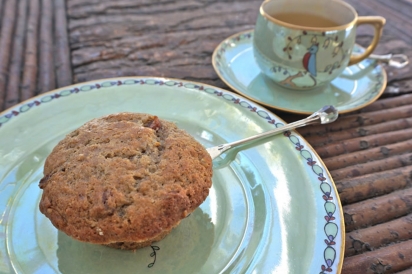Poschaven Farms Offers Gluten-Free Ontario Buckwheat
Many staples of the gluten-free diet—quinoa from the Andes, sorghum from Africa, and rice from Asia—can't be grown in Ontario. This has always challenged my preference for buying food from local growers. A turn for the better came last November at the Royal Agricultural Winter Fair in Toronto when I encountered George Posch and his quality source of Ontario-grown gluten-free buckwheat flour.
Here's a crop that actually prefers Northern Ontario's short growing season. Poschaven Farms' buckwheat thrives on the deep, fertile soil of a glacial basin 200 kilometres north of North Bay.
Bruce Posch grows his buckwheat separately from spelt and other gluten-containing grains on his brother George's land, an essential precaution. George started milling grain for his family's consumption and took some buckwheat to the Royal five years ago. In response to customer requests, he recently acquired a second stone mill so the buckwheat could also be processed and stored separately, making it safe for people with celiac disease. This might seem like a lot of trouble but it's essential to the clientele of dedicated gluten-free bakeries.
I'm not keen on the gluten-free diet as a fad. It has rapidly expanded the availability and choice of foods, but it can also trivialize food safety for people with a serious medical concern such as celiac disease or non-celiac gluten sensitivity (which I've been diagnosed as having), both of which are reactions to certain proteins in wheat, rye, barley, and closely related grains.
As a journalist, I've investigated the science of gluten, reviewing papers and interviewing clinical gastroenterologists and food scientists. I've found no convincing evidence that wheat has any sinister effect on the vast majority of people. Gluten-free food can be nutritious and delicious, but just because something is gluten free doesn't make it inherently healthier; some of these products actually contain more starch and sugar just to make them palatable.
With no known cure for celiac disease, the diet is a lifelong commitment, and not one to be taken lightly. It requires careful scrutiny to ensure proper nutrition. Anyone who suspects they're sensitive to gluten should consult a doctor before taking further steps.
The diet has, however, provoked my fascination with healthy food, resulting in knowledge I can cook with and share with people close to me, regardless of any dietary concerns. I've overcome the vaguely cardboard stereotype of these foods. In fact, some gluten-free baking tastes better than the conventional alternatives as I remember them. Excellent local ingredients make the process even more enjoyable.
Buckwheat is unrelated to wheat, falling in the same broad-leaved family as rhubarb and sorrel. Cultivation originated in Southeast Asia as early as eight thousand years ago, but arrived in Europe soon after. The Posches have struck a winning formula in Northern Ontario.
Since George was already bringing buckwheat to the Royal Agricultural Winter Fair, last year Bruce set up an adjoining booth for honey from his farm. Buckwheat depends on bees for pollination. Bruce relates that he has been farming organically for decades because he saw his dad, father-in-law, and many farmers of their generation die of cancer. "They farmed after World War II with the idea that chemical sprays were the way to go." He explains that, "I had learned quite a lot from my grandfather and dad of how they farmed before sprays, and how they rotated crops to recycle fertility. I developed my own program over twenty-five years, using some methods that are not considered orthodox, even by organic farmers.
"Many agrologists think plowing is bad, but if done correctly it can increase carbon and organic matter in the soil with no erosion. The secret is timing, increased oxygen levels, and green manure. It doesn't matter if manure is from the back end of a cow or the back end of earthworms. If we feed the plants directly to soil organisms, we save all the fuel and effort of handling, storing, and hauling manure back to the field.
"I never work the ground in the fall, so weed seeds do not replenish the seed bank in the soil," Bruce continues. "I let them germinate in the spring, let them grow, and plow them in as green manure. Every acre I farm has green manure every year because of this technique, and the weed pressure is less than when I moved here.
"When I plow and the soil is warm, I get out of the tractor and love smelling the soil, and running my hands through it. It's full of soil life: earthworms, beetles, rhizobia bacteria," Bruce enthuses.
When the bacteria receive a buffet of green manure, the soil heats up quickly. Bruce plants the buckwheat seed within days and it germinates within 96 hours, two weeks ahead of any weeds. "My crop yields are more now per acre than when I bought my first farm," he adds.
Buckwheat is a short-season crop but not frost hardy, Bruce says, so it's a race to the harvest before first frost—around the first of September.
"I lose some acres most years, but the acres that survive can run tremendous yield," he declares. "Buckwheat likes lots of rain and hot days with cool nights. That's our climate."
Bruce's entire crop used to go to a single buyer for the European market. Since 1994 it has met stringent standards for organic certification. This buyer takes all the buckwheat Bruce can give him. "It is getting to be a bit of a problem here because both my buyer and George need more buckwheat," says Bruce. "I need to expand, and have some kids [who need] to hurry up and come home from school. But I don't want to force them before they are ready."
He had already been growing buckwheat on gluten-free ground and storing it separately for the buyer, but to meet demand from George's customers at the Winter Fair, a separate mill was also needed to guarantee no contamination from gluten.
George recalls that, "Last year I bought a larger stone mill built in the U.S. that I housed in a temporary facility to see if the market would accept it. The market expanded several-fold this year. Today I am just finishing a new building to move the new buckwheat mill into."
For better sustainability, he installed under-floor water heating so he can burn hulls and chaff to heat the facility. He plans to use solar panels for electricity.
George tells of a woman from Tibet who buys hundreds of small packages of buckwheat flour each year to distribute to her family for making traditional soba noodles. He personally delivers to some Southern Ontario customers and small stores to avoid distribution costs and "keep it affordable for people that need it."
George makes mention of the dearth of organic, gluten-free seed crops grown by Ontario farmers: "It is one reason why we have put some effort into it. The big chains want to just handle one buckwheat brand from the States, and it is not gluten free."
For myself, I like how the array of gluten-free flours opens up a subtle palette of flavours. Sorghum has a soft texture and wheat-like taste ideal for sweet baked goods. Quinoa is hearty and nutty. Amaranth has a green flavour suitable for savoury foods like meat-pie crusts and gravy.
With so many options, buckwheat had fallen under my radar until last year at the Royal. I brought home two bags: Poschaven Farms buckwheat flour and buckwheat pancake mix, both winners. Buckwheat has an earthy, nutty flavour. I was inspired to substitute it for brown rice flour in my favourite muffins, a quick success with friends (including this magazine's publisher and editor), who requested the recipe even though they don't follow gluten-free diets.
Knowing that George delivers buckwheat for use by Organic Works Bakery in London, I contacted owner Peter Cuddy to see if a professional likes it as well as I do. He declared, "Bruce Posch and his brother George are excellent growers and millers, probably the best that I've found anywhere in the industry. We used to buy U.S. buckwheat but I could not control the quality of the product."
Buckwheat from the Canadian prairies is subject to cross-contamination by wheat, in his opinion, so "the beauty of George and Bruce's setup is that they have their own milling operation. It's a co-operative relationship and we do really, really well. Their product is probably the best buckwheat I've ever seen." He also notes that buckwheat is an excellent source of protein, almost as good as quinoa and amaranth.
Bruce identified a few stores that sell Poschaven Farms' buckwheat flour and pancake mix. They include Crѐme Fraîche Market Café and Butcher by Nature in Toronto, The Gentle Rain in Stratford, and Carluke Orchards in Ancaster. George also personally delivers to some customers near his travel route.
This morning I ate my first slice of pumpernickel bread in many years, fresh from my own oven. Maybe it's not real pumpernickel, traditionally made with rye; mine contains buckwheat flour, caraway seeds, and molasses, among other things. But it's fragrant and flavourful, another step in the adventure of taking a challenge and making something better out of it.
Gluten-Free Apricot Pecan Muffin
Not all conventional baking converts easily to gluten free, but I find that muffins made without wheat flour can be superior. Don't worry about over-stirring the batter; without gluten it won't become stiff. Sorghum flour softens the texture and lightens the flavour.
Editor's note: Unable to source Poschaven Farms buckwheat flour for testing this recipe, I used Cuisine Soleil certified gluten-free organic buckwheat flour, which is made using buckwheat grown in Ontario, Quebec, and New Brunswick.
Makes 12 large muffins
Ingredients:
- 1/2 cup pecans, chopped
- 1/2 cup dried apricots, chopped
- 2 generous chunks candied ginger, finely chopped
- 1/4 cup pure maple syrup
- 3/4 cup sorghum flour
- 3/4 cup brown sugar or granulated cane sugar
- 3/4 cup organic cornstarch
- 2/3 cup buckwheat flour
- 1 tsp xanthan gum
- 3/4 tsp salt
- 1/2 tsp baking soda
- 1/4 tsp gluten-free baking powder
- 2 large eggs
- 1 1/3 cups plain yogurt
- 1/2 cup avocado oil extra virgin olive oil
- 1 tsp pure vanilla extract
Instructions:
Grease a 12-cup muffin tin; set aside. In a small bowl, stir together the pecans, apricots, ginger and maple syrup; set aside. In a large bowl whisk together the sorghum flour, sugar, cornstarch, buckwheat flour, xanthan gum, salt, baking soda and baking powder; set aside. In a medium bowl, whisk together the eggs, yogurt, oil and vanilla.
Add the yogurt mixture to the flour mixture, stirring until smooth. Lightly fold the pecan mixture into the batter, leaving small clusters. Spoon the batter evenly into the muffin cups. Bake in a 375° F oven until the muffins are light brown and firm to the touch, 30 to 35 minutes. Cool on a wire rack for 5 minutes. Remove the muffins to the rack to cool completely.






